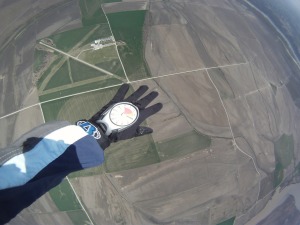My Fearless Nosedive (and Accepting Blame)
By Dr. Cathy Greenberg
 One of my fearless goals was to get an A license in skydiving.
One of my fearless goals was to get an A license in skydiving.
To qualify for the license I needed several things:
- To have taken a number of jumps at various heights,
- To be tested in my positioning upon jumping from the plane and opening my chute,
- To be tested in my ability to flare (the act of pulling down the breaks of the canopy in order to slow it down),
- To land safely.
Since I commit to surrounding myself with the best teachers I can find, I learned to skydive with a series of jump masters, several of whom were both active-duty and former Special Operators (Spec Ops personnel).
My first 45 jumps were straightforward.
One particular maneuver, though, always seemed to be just outside my reach. This was the High Altitude, Low Opening jump, known as a HALO. In it, the parachute isn’t actually pulled until you’ve reached a much lower altitude than usual.
HALO jumps are a fairly common across the military. Spec Ops team members often use this technique in both their “quals” (a mandatory annual qualification or readiness assessment) and, on duty, to land behind enemy lines without being seen.
I found the HALO difficult, despite my skills in jumping. I’d even carefully procured my equipment under the supervision of the LEAP FROG Navy SEAL jump team at the time. So I knew I had the best and the safest equipment possible (including one, a cypress, that saved my life more than once). A cypress is a small computer that automatically releases your shoot regardless of your being conscious, capable or ready. It is set in advance for altitudes that make sense for the level of the student. In mind in my case, as a student, the parachute was set to open at an altitude of 3,500 feet off the ground no matter what.
The first time I tried a HALO jump, I broke my left toe on landing.
The second time, I tore the meniscus in my left knee (which as anyone who’s suffered an injury like this can attest to, results in excruciating pain). I was laid up for a few weeks, but I did not listen to the doctors who insisted I stay off the leg for a while. I was actually jumping again just a few weeks after my second injury to the same leg.
I was now jumping with a broken toe and a badly damaged knee. I was hanging out with some pretty tough characters who expected me to keep up or shut up. Like a trooper, I kept up, shut up and “hung loose” with the best of them. Our code words were, “Are you solid?” My response was always, “Yes sir, I’m solid.” I was anything but solid. It was all a mental attitude.
The third time, I jumped out at between 12,000 and 13,000 feet. This time I fractured my coccyx bone into four parts, and also fractured my L1 and L5 vertebrae.
Maybe I wasn’t as solid as I’d said.
But I was tough and I certainly had gained the respect of these highly trained professionals around me. That meant the world to me as a civilian.
On one bright May day I 2006, I was jumping with a friend on this friend’s birthday. I was trying to jump in cool 39-degree air at a good altitude but without the benefit of recent altitude or heat inoculation . After all, I had been injured and was not jumping as often as I had been in the weeks leading up to my prior accidents.
It was about 110 degrees on the desert ground but I had already passed out at around 5,000 feet off the ground. Unconscious, I was unable to pull the chord. Luckily, I had the cypress, which automatically opened my shoot for me around 3,500 feet off the ground.
When I finally came to, at 800 feet off the ground, the earth was rapidly approaching. I immediately tried to push myself in the direction of the big yellow X that marked the landing at the drop zone. As I struggled with my uncooperative body, I tried to look for my team.
They were spread across the ground watching in horror.
In the next blog: what happened after.
For questions about this post or for information on becoming a fearless leader, contact Dr. Cathy Greenberg and The Fearless Leader Group at (888) 320-1299 or by email at hello@fearlessequalsfreedom.com.





No comments yet.